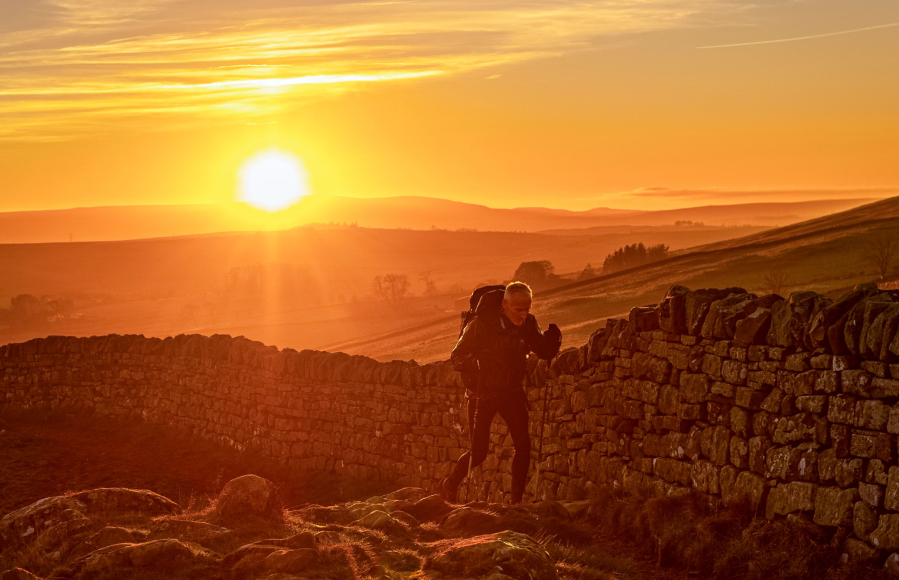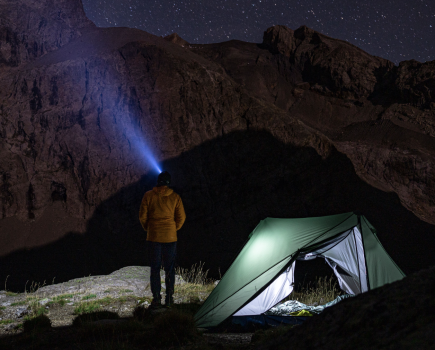As the Pennine Way celebrates its 60th birthday this year, our latest issue of The Great Outdoors honours big trails in Britain and beyond.
This Winter, trail-loving people up and down Britain set their sights on the Pennine Way as hundreds of hardy runners set off on the Montane Winter Spine Race. Evocative images from the event pepper the pages of this issue. The podium stars earn their stripes without doubt, but what of everyone else? The dreamers, enthusiasts, the gung-ho and the geeks – everyday people who elect to try something extra-ordinary on this bucket list trail that splits England.
Main image: First light on the Spine Race | Credit: Adam Dean
This month we celebrate the lives and times of the Pennine Way, England’s original long-distance path – 60 years young in 2025. It’s a keystone trail for everyone, a line made by walking, or indeed running, that hefts people to place. In A Pennine Journey, Wainwright reminds us that real is what we give our time and attention to. “Let your anticipation run riot, plan and dream of things far above your grasp… Plan new achievements, and set about achieving them. Failure and disappointment simply don’t matter; go ahead with your dreaming, let your enthusiasm run away with you.” We hope this issue whets the appetite for your own.
Highlights of this issue:
- The Pennine Way at 60: everything you need to know to walk the walk
- Michaela Hrdá and Martina Merisi cross the roof of the world on the Pamir Trail
- Carey Davies realises a bucket list trail through Fisherfield in the North-West Highland
- Alex Roddie pays close attention on a very different journey in Ireland; the Beara Way
- Find some trail magic with adventure filmmaker Elli Schneider and her dog, Otto
- Eat well on your bucket list trail with recipes for affordable DIY backpacking dinners
- Get close to nature on expertly-mapped walks into fauna territory
PLUS: Jim Perrin paints a portrait of Mam Tor; honest and trusted reviews of the best waterproof jackets and power banks; the latest news from the mountains, outdoor walking festivals we rate; and our reviews of new outdoor books and films to inspire.
Find your bucket list trail:
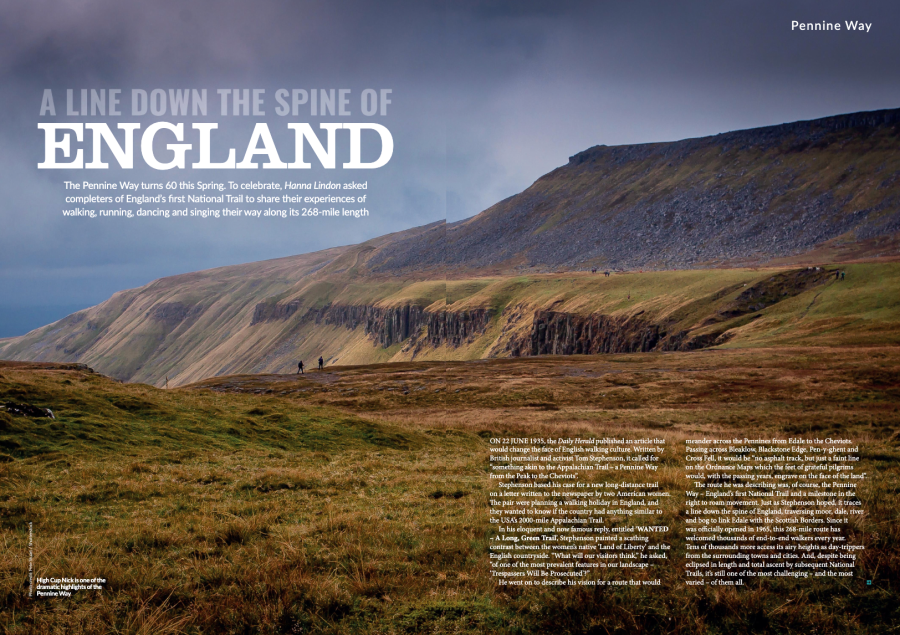
A Line Down the Spine of England: The Pennine Way turns 60 this spring. To celebrate, Hanna Lindon asked completers of England’s first National Trail to share their experiences of walking, running, dancing and singing their way along its 268-mile length.
“When we first did it, I think only five or six years had passed since the Pennine Way opened. Whoever designed it never anticipated the traffic it was going to get. You’re walking over peat a lot of the time, and it had just turned into a sort of thick, black soup. On Kinder and Bleaklow, we were literally sinking in places up to our knees. And because we were carrying heavy packs, we sort of pitched forwards onto our faces and couldn’t get up. We had to wriggle out of our packs to get back to standing. Nowadays a lot of those vulnerable tracks have been paved, so you’re walking on hard surfaces a lot more. Oddly enough, that gave me a lot of problems – I got really bad blisters! Also, there was a level of hostility to walkers in those days in certain places. A lot of pubs saw you in your old, battered clothes and your ragged, mud-splattered boots, and they thought ‘these people are impecunious – we’ll get no trade from them’. They really discouraged walkers from coming in. But at some point, they clearly realised that the trail of walkers going past their door had money in their pockets. One of the pubs that wasn’t very keen on us the first time round had changed its name to The Jolly Rambler.”
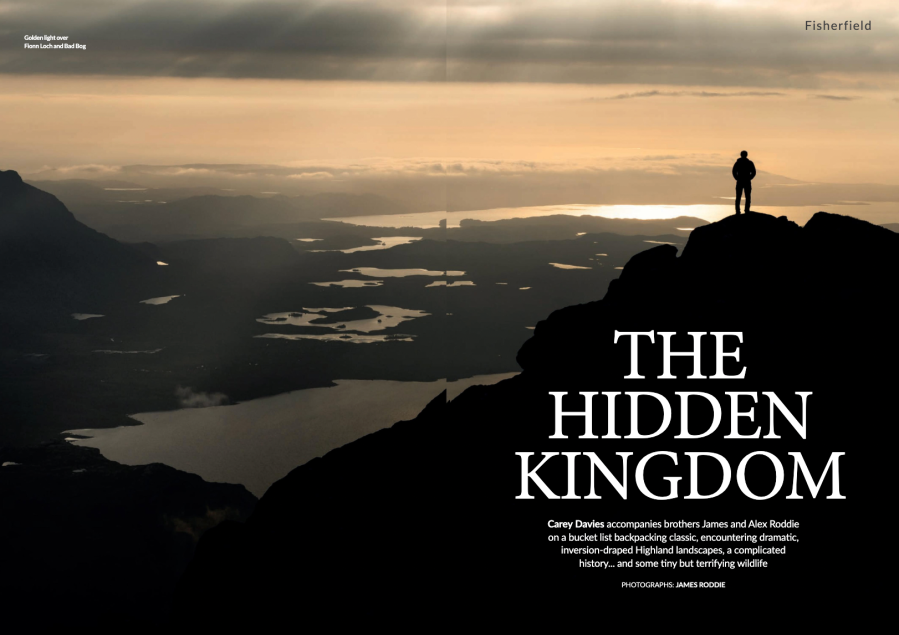
The Hidden Kingdom: Carey Davies accompanies brothers James and Alex Roddie on a bucket list trail, journeying through dramatic, inversion draped Highland landscapes, a complicated history… and some diminutive but terrifyingly itchy wildlife.
“A bloodthirsty swarm writhed and seethed inches from my face, a blizzarding black static of insects that actually made the world dimmer. Even as the rays of the sunset glowed on the high flanks of An Teallach above, an early dusk engulfed my tent as what felt like most of the midge population of Wester Ross formed a dense squirming ball around it. The mesh of the inner tent seemed to be doing a reasonably good job of holding this itchy apocalypse at bay, but dismay slowly dawned as my bladder informed me I would eventually need to unzip the tent to venture outside. After a fruitless search for receptacles that might avert the need for this excursion, I resigned myself to my fate, Captain Oates-style, then fumbled out into the hail of tiny jaws, letting a host of the little tyrants rush through the breach in the process. Later, back in the tent, as owls hooted in the alder trees and deer barked demonically into the darkness, my headtorch beam revealed a whole ecosystem of midges flying around inside my temporary home. Oh well. I came here to be immersed in nature – and what better way to do that than becoming part of the food chain?”
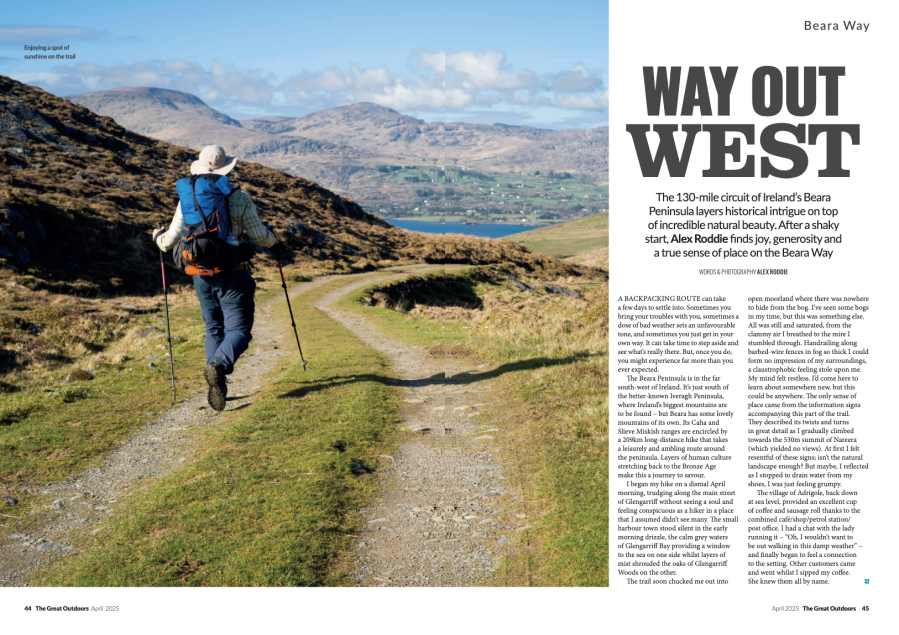
Way Out West: The 130-mile circuit of Ireland’s Beara Peninsula layers historical intrigue on top of incredible natural beauty. After a shaky start, Alex Roddie finds joy, generosity and a true sense of place on the Beara Way.
“The sun was out, and my exploration of Bere Island revealed many treasures. A Martello Tower, finished in 1805 as a defence against French invasion, stood proud on Ardagh Hill with commanding views over the harbour and the rugged Caha Mountains beyond. I visited the coastal village of Rerrin with its pastel painted houses. Then I carried onto the far eastern tip of the island, where I squinted through wire fencing at the abandoned artillery of Lonehort Battery. The largest of seven batteries on Bere Island, this was active during World War I but has long since been given over to the sheep. I wondered if the farmers and fisherfolk – who lived here in their thousands before famine and poverty drove them away – welcomed or cursed these extensions of the military-industrial machine into their home. On my way back west towards the lighthouse at Bere’s western point, I passed a Bronze Age standing stone known as the Gallen. Standing three metres high and proud on a hilltop next to the trail, it’s said to mark the island’s centre on both axes. Nobody knows how the people who put it there made their measurements. As the ferryman had promised, the sheep-cropped lawn next to the lighthouse made a perfect pitch for my tent. I sat on a rock in the golden evening light watching waves crash over the sea cliffs. Later, after turning in, the beam of the light began flicking out over the sea, its glow spilling through the thin fabric walls of my portable home…”
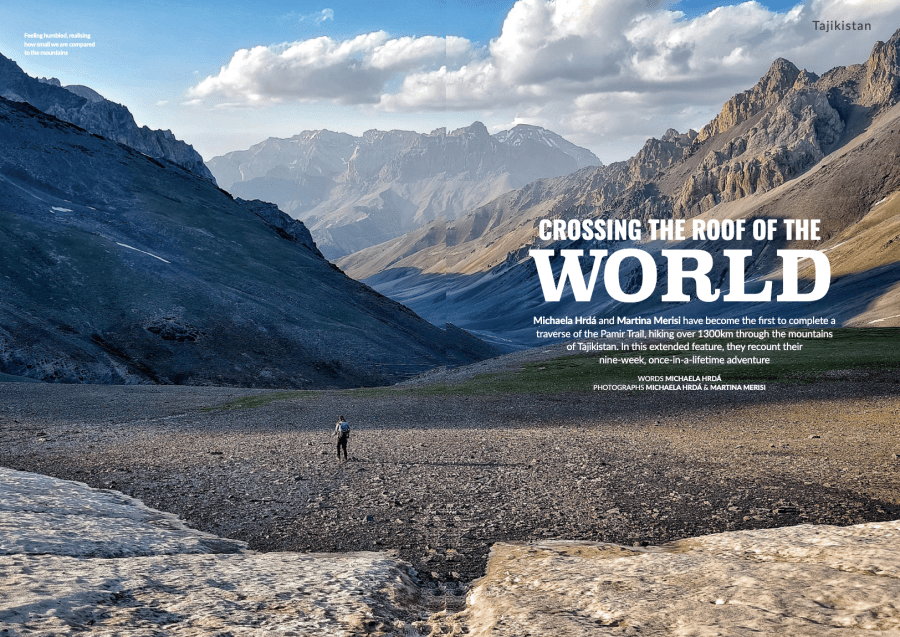
Crossing the Roof of the World: Two Czech women – Michaela Hrdá and Martina Merisi – have become the first to complete a traverse of the Pamir Trail, hiking over 1300km through the mountains of Tajikistan. In this extended and exclusive feature, they recount their nine-week, once-in-a-lifetime adventure.
“The Pamirs sit at the junction of many of Asia’s (and the world’s) highest ranges – the Hindu Kush in Afghanistan and Pakistan, Kyrgyzstan’s Tian Shan mountains and the neighbouring Kunlun in China. It’s a vast region of snaggle toothed peaks, high plateaus and wide, verdant valleys carved by immense glaciers, ventured into by legendary figures like Marco Polo and Frances Younghusband, squabbled over by Russia and China, a multicultural meeting point and melting pot for Tajik, Pashto, Urdu and Uyghu speakers. A civil war in the late 90s devastated the country, which is now very slowly recovering. Jan Bakker is working with both exploratory hikers and local communities to make the trail a reality that benefits the country and the people, sometimes coming up against local political and tribal unrest and reckoning with an almost complete lack of formal trail infrastructure… the last of which, for us, was a large part of the attraction. We gathered information on the known details for each stage of the route so far. He explained he hadn’t expected anyone to give the full route a try so soon – there were still one or two nagging gaps in his itinerary…”
Order a single copy of this issue and get it delivered with free postage.

